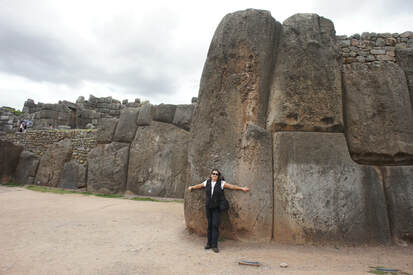 Shaman carefully placing the ceremonial objects that will be given in honor to Pacha Mama. Shaman carefully placing the ceremonial objects that will be given in honor to Pacha Mama. Going into my second week here in Peru I find myself waiting, as I knew I would, for my "Convenio"...the permission paperwork I need to work on the Saqsaywaman archaeological park. I drafted a whole research proposal and it is being translated into Spanish at this moment. It will be submitted to the park management on Friday and then we will be doing a Pacha Mama ceremony there. Whenever you work on the land here in Peru, you honor the spirit of Pacha Mama by making an offering. I've done this each time I've been here and I'm hoping this time to be able to film this sacred ceremony. I will be working with a Shaman and the people at the Ministry of Culture. And, I'll have my friend/blogger Miriam Sieden with me as well as Fiorela from Maximo Nevel to help with the translations. More on this ceremony next blog.  Maren against one of the largest of Saqsaywaman's megalithic stones. Maren against one of the largest of Saqsaywaman's megalithic stones. So, in the meantime, I've been visiting the various amazing ancient sites here in Q'osqo and engaging in my secondary research passion...ancient stone architecture. A little history on this aspect of my passion for Peru is needed. When I first arrived at Saqsaywaman in 2010, I knew the archaeological park was dedicated to the preservation of the main temple complex wall. And, I knew this wall was made of megalithic stones. But, what I didn't know then was that there really are several types of stones in various types of architecture here in Saqsaywaman and in the general Q'osqo area...and beyond. Thus, starting in 2010, I starting studying the ancient stone structures found here In Peru (Andes & coastal). When I immersed myself in this research, I also found that there are megalithic stone structures around the world that are similar to those here in Peru. Over the years since 2010, I've become fascinated with the documentation of these locations and am trying to understand what all these stone ambassadors from the past have to tell us about our human history on this planet as a whole. Stone Types In Q'osqo, Peru Let's start where I started, with the various stone structures here in Q'osqo and up the hill at the Saqsaywaman archaeological park. Everywhere you walk here in town and up in Saqsaywaman, if you look closely, you notice that some stones looks much more finished and perfectly fitted together than others. It doesn't take much of a walk to find examples of stone walls where the lower course (most often the oldest) is the most perfect in construction, whereas the stones on the top are often crude. This anomaly challenges our belief that human cultural progress, including architectural skills, should be at their peek now. But, what we find here in Peru is that the oldest structures are often the most perfect and the newer architecture, especially the contemporary work, is often crude and imperfect.  Maren sitting by a perfectly cut rock structure at Saqsaywaman, the purpose of which is still a source of research. Maren sitting by a perfectly cut rock structure at Saqsaywaman, the purpose of which is still a source of research. Controversy About The Stones There is quite a bit of controversy about the age of these stone artifacts, the way the stones were cut, moved, and placed in these massive walls and buildings. There are archaeological opinions. There are ancient alien theories. There are names for the types of stone work based on the type of rock, the design of the stone, the presence of a vitrified surface (that indicates some source of heat melted the surface)...there is NO lack of theories about these various stone buildings and walls and who made them. The one consistent factor is that there really isn't a definitive theory, that everyone can agree on, as to the history of these stone structures. The other consistent factor is that people who see these stones are almost always amazed at their construction and wonder "how did the ancient people who were supposed to have simple stone tools and copper chisels make these structures?" The diversity in the types of stones and perfectly cut structures (like the one Maren is sitting by) is mind blowing. Everywhere you go in Q'osqp and up at Saqsaywaman, you encounter stones that defy explanation and boggle the mind. For me...understanding the message these stones have for us is a pursuit that keeps me busy in my off time. I love finding a new documentary about these enigmatic stones around the world; the new academic paper by a peer; or coming across a new structure or stone I haven't seen before here in Peru.
1 Comment
|
Author
Maren Elwood is a visual anthropologist and founder of On-Site Expeditions...a field school that will provide scholarships to aspiring heritage professionals. The first field school session will be in January 2020. Archives
September 2023
|
